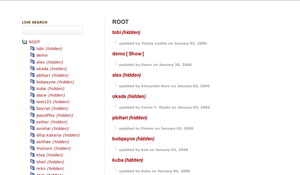Measure Laws
The list of weblogs ranked by poularity is not a hierarchy in that sense, however. It is instead a ranking by status. The difference is critical, since what’s being measured when we measure links or traffic is not structure but judgment. When I’m not the CEO, I’m not the CEO because there’s an org chart, and I’m not at the top of it. There is an actual structure holding the hierarchy in place; if you want to change the hierarchy, you change the structure.
When I’m not the #1 blogger, however, there are no such structural forces making that so. Ranking systems don’t work that way; they are just lists ordered by some measured characteristic. To say you want to subvert that sort of hierarchy makes little sense, because there are only two sorts of attack: you can say that what’s being measured isn’t important (and if it isn’t, why try to subvert it in the first place?), or you can claim that lists are irrelevant (which is tough if the list is measuring something real and valuable.)
Clay Shirky on Many2many (in the context of the recent gatekeepers discussion)
Ninged and Flocked
Umair Haque on barriers to growth for 2.0 at the moment
Ninged:
shorthand for a chasm in usability. Though you’ve created new market space, the share of that market that’s valuable in the real world is tiny; though many might want to use this set of services, only geeks can use them – you’ve built a better mousetrap, but only [geeks] can figure out how to use it.
Flocked:
shorthand for a chasm in needs. Though everyone can figure them out, they create little market space: only geeks want these services – you’ve built a better mousetrap, but it only catches very, very small subset of mice.
The Mixed Grill
Just got myself the Mixed Grill – a special offer from TextDrive which for a one-time payment of $499 gives you lifelong access to shared hosting (Shared 2) at TextDrive, 9 GiB of storage at Strongspace and the Startup Plan of Joyent (who recently bought TextDrive.)
If you can spare $500 it’s worth checking out.
Hierarchy
2 more interesting open source applications for Rails – both of them tweak our notions of hierarchies:

Hieraki [hieraki.org] which lets you to organize digital documents in a hierarchical tree structure

Fugi is a different kind of forum
Value for Money
Joshua Schachter on why he picked icio.us
When .us became available, I wrote a quick script to figure out the shortest prefixes that would allow me to generate the most number of names:
$ grep us$ /usr/dict/words | sed ‘s/.*\(….\)\(us\)$/\1.\2/’ | sort | uniq -c | sort -n | tail
6 aceo.us
6 mino.us
7 ario.us
7 onio.us
7 urio.us
8 aneo.us
8 orio.us
10 itio.us
14 icio.us
18 acio.us
Reinforcing Information
But there’s a problem. Ever since I’ve started using [memeorandum] to the point where it replaces many of my other sources, I have gotten stupider.
… This is a well-known phenomenon in psych and econ – I’ve been locking myself into a diet of reinforcing information. Nothing really challenges my beliefs, and so I get hyperpolarized, or echo-chambered, sure – but the deeper effect is that I also get stupid, fast.
Part of the reason is that all the attention markets, reconstructors, etc push all the same stuff to the top – they all converge to the same equilbirum. Paradoxically, it’s an environment of incredible diversity, but incredible sameness at the same time.
Umair Haque on memeorandum
Fairy Tale
Because Web 2.0 is everything and nothing all at once. Materially it is basically nothing: a melange of technologies, most not that new. But conceptually it is everything: a rethinking of the way we view web applications and data management, a re-vision of how we approach the user interface.
…
That’s what Web 2.0 is. A shorthand. It represents something good – a good change in the way web apps work, a good refocusing on user’s needs for functionality and data transperancy, a welcome turn of attention back to making a better web UI. Like all such terms, it will mean different things to different people at times, and venture capitalists will create a bubble around it – but what’s the harm for all that good.
Chris Lott responding to Jeffrey Zeldman’s Web 3.0 (a modern fairy tale.)
Public and Private
There are going to be so many permutations and approaches to making sense of private tags and public tags (where “private” = done for oneself, but still accessible by the public). This will all intersect with social networking software, analyzing tag usage among users who know one another and users who are share interests and demographics. We need, imo, room for both public and private. That’s why I’d like social tagging sites to allow me to designate a tag as private.
David Weinberger commenting in his What is a folksonomy anyway?
Beta 500.0
The MoMB just hit a mind-boggling 500 entries mark.



Cough, cough

First things first: Happy New Year!
Second things second: sorry for the unannounced stealth mode of Blog before you Think! during the last few weeks. I had the opportunity to visit Shanghai for a couple of days on short notice in december and was chilling in Vienna without convenient access to the internet for three weeks.
Third things third: I’m in the process of switching this blog from Blogger to Textpattern and I still need to figure out the odds and ends, so a few things might look weird or not work at all.